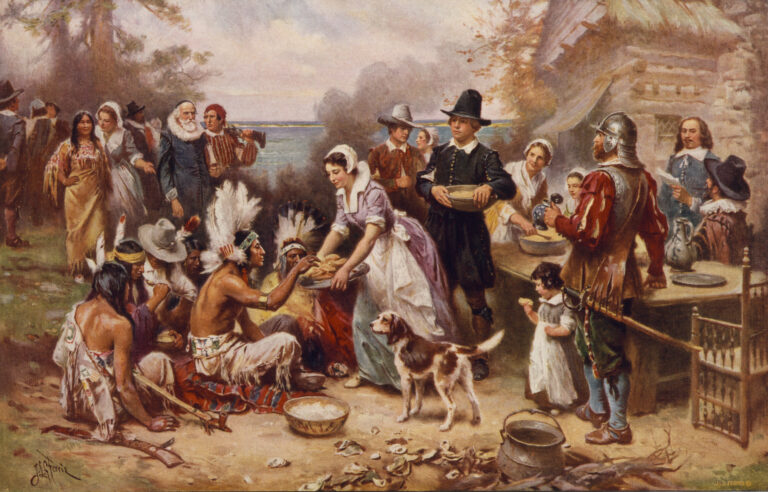If you’ve been hunting high and low for a Thanksgiving menu to razzle and dazzle your guests, look no further than the first ever menu from the First Thanksgiving in 1621. You will be the talk of the town, and this time, in a good-ish way.
The story goes like this: After 66 days at sea, the Pilgrims arrived in Provincetown Harbor in their Mayflower ship on November 11, 1620. Seeking religious freedom in the New World, they established Plymouth Colony in Massachusetts, but were greeted with a challenging and harsh landscape. The cold and bitter New England winter took a heavy toll on them, with limited food supplies, inadequate shelter, and exposure to the elements. Over half of the Pilgrims perished during that first winter, and their situation seemed dire.
However, they received crucial assistance from the indigenous Wampanoag people, who taught them how to cultivate native crops like maize (corn) and where to fish and hunt for sustenance. This knowledge-sharing and cooperation led to the bountiful harvest of 1621, a moment of celebration and gratitude that is commemorated today as the First Thanksgiving.
The Pilgrims, dressed in their austere, 17th-century attire, and the Wampanoag natives, adorned in earth-toned garments adorned with intricate beadwork, gathered together for a monumental feast held over three days. This event marked the beginning of a complex but ultimately evolving relationship between Native Americans and European settlers in North America. Together, they created a timeless tableau of unity and shared abundance in the face of an untamed land, marking the genesis of a cherished American tradition.
It was a ‘whose who’ event: Some of the notable Pilgrim figures present at the First Thanksgiving included Governor William Bradford, Myles Standish, and Edward Winslow, among others. At least 90 members of Wampanoag tribe were present.
While there is no detailed menu from the event, historical records and accounts provide some insights into the types of foods that were likely present at this early Thanksgiving celebration. Traditional foods that may have been eaten at the First Thanksgiving include:
Wild Game
The Pilgrims and the Wampanoag likely enjoyed a variety of wild game, such as venison (deer meat), waterfowl (ducks and geese), wild turkey, and small game like rabbits and quail. These bountiful offerings were prepared through roasting over open fires, smoking, or stewing. The flavorful meats were seasoned with native herbs, spices, and ingredients, resulting in a diverse and hearty spread that celebrated the rich natural resources of the land and the spirit of cooperation between two communities.
Fish
Given Plymouth’s proximity to the Atlantic Ocean, fish, including cod, bass, and other local varieties, would have been readily available and probably eaten a few times over the few days of celebratory gathering. They may have roasted, smoked or stewed the fish in chowders or stews.
Corn
Corn, a staple crop for both the Native Americans and the Pilgrims, would have been a significant part of the meal. It might have been served in various forms, such as cornmeal porridge or cornbread.
Squash
Different types of squash, such as pumpkins and other winter squashes, were cultivated and could have been used in various dishes. Squash, along with corn and beans, was one of the “Three Sisters” crops in Native American agriculture. These crops were traditionally grown together and held cultural and agricultural significance for many tribes, including the Wampanoag.
Beans
Many types of beans, including kidney beans, pinto beans, navy beans, and lima beans were a staple among Native Americans, and were likely served as part of the meal. Beans were likely prepared by boiling, stewing, mashing, drying or baking methods.
Berries and Nuts
The Wampanoag tribe diet including locally foraged berries and nuts, including native cranberries, blueberries, strawberries, blackberries, raspberries, and nuts such as acorns, chestnuts, and hazelnuts.
Seafood
In addition to fish, shellfish like clams, mussels, and lobster were likely part of the coastal diet and could have been incorporated into the meal.
Root Vegetables
Common root vegetables of the time included carrots, turnips, and possibly parsnips. These vegetables could have been prepared through roasting, boiling, or stewing, depending on the culinary traditions of the Pilgrims and the Wampanoag. Roasting might have involved cooking the vegetables over an open fire or in earthen ovens, while boiling would have resulted in tender and flavorful additions to stews and one-pot dishes. The use of native herbs and spices could have enhanced the flavor of these root vegetables, making them hearty and wholesome for young and old.
Herbs and Spices
Native Americans used a variety of herbs and spices to season their foods, including sassafras, wild garlic and onions, mint, wintergreen, and salt. European settlers brought herbs and spices like cinnamon, nutmeg, and herbs like thyme and parsley, which could have been used in cooking.
Fruits
Depending on the season, fruits such as cranberries, blueberries, and plums might have been available and could have been used to make sauces, preserves, or desserts.
Bread
The Pilgrims likely had several forms of bread or baked goods, made from cornmeal or wheat flour. Cornbread, made from ground cornmeal, was a staple, often baked as flat cakes or loaves. Rye bread, denser and darker than wheat bread, was crafted from cultivated rye. Wheat bread, though less common due to wheat’s challenges in the New England climate, was occasionally made from locally grown wheat. Unleavened bread, which did not use yeast or leavening agents, was also present, and it could be flat and quickly cooked. Some breads were enriched with dried fruits, nuts, or berries, while others, known as ash cakes, were simple mixtures of cornmeal and water cooked directly on hot ashes.
Venison Pies
Historical accounts suggest that the Wampanoag brought five deer as gifts to the feast, so venison could have been a significant part of the meal, possibly in the form of pies or stews. These pies featured tender cuts of venison, obtained from deer that were hunted for their meat. The venison was typically diced and seasoned with a variety of herbs and spices, which might have included native herbs like sage and thyme. The seasoned venison was then encased in a flaky pastry crust made from flour, butter, and water. These hearty pies were a popular way to enjoy the rich flavors of game meat and could be baked in communal ovens or hearths. Venison pies served as a centerpiece dish, celebrated for their taste and as a symbol of the abundance of the harvest season, making them a fitting addition to the First Thanksgiving feast.
Cider and Water
Beverages like cider (non-alcoholic at the time) and fresh water would have accompanied the meal. Cider was a common beverage during the time of the First Thanksgiving, and it likely made an appearance at the feast. Both the Pilgrims and the Native Americans, including the Wampanoag, were familiar with apple cultivation and the production of apple cider. Apples were one of the fruits that the Pilgrims brought with them from Europe, and they planted apple trees in the New World.
Cider could be made by crushing apples to extract their juice, which was then fermented to produce hard cider. Depending on the fermentation process and the length of time it was allowed to ferment, cider could vary in alcoholic content, from mildly alcoholic (similar to modern apple cider) to stronger alcoholic beverages.
At the First Thanksgiving, it’s possible that both alcoholic and non-alcoholic versions of cider were served, providing a refreshing and flavorful beverage option to complement the meal. It’s worth noting that clean water sources could sometimes be scarce, so cider and other beverages were important for hydration as well as enjoyment.
Bon Appetit
Whatever you choose to include at your own Thanksgiving will be a magical addition to this centuries long tradition. Rejoice in the meaning behind Thanksgiving. Teach your children to be thankful and be giving. Because when we share, help and be kind to others, that’s how we shine the most.
Bottom line, if these menu items can bridge the gap between the Native Americans and Pilgrims at a critical part of American History, surely it can help your ragtag bunch.


